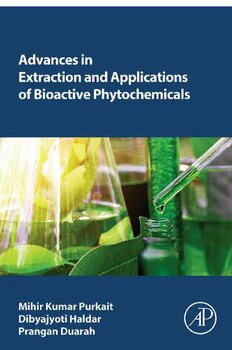Table Of ContentAdvances in
EXTRACTION AND
APPLICATIONS OF
BIOACTIVE
PHYTOCHEMICALS
This page intentionally left blank
Advances in
EXTRACTION AND
APPLICATIONS OF
BIOACTIVE
PHYTOCHEMICALS
MIHIR KUMAR PURKAIT
Department of Chemical Engineering,
Indian Institute of Technology Guwahati, Guwahati,
Assam, India
Chair Professor, National Jal Jeevan Mission (NJJM),
Government of India, New Delhi, India
DIBYAJYOTI HALDAR
Department of Biotechnology, Karunya Institute of
Technology and Sciences, Coimbatore, Tamil Nadu
PRANGAN DUARAH
Center for the Environment, Indian Institute of
Technology Guwahati, Guwahati, Assam, India
AcademicPress isanimprintofElsevier
125London Wall,London EC2Y5AS,UnitedKingdom
525BStreet,Suite1650,SanDiego,CA92101,UnitedStates
50HampshireStreet,5thFloor, Cambridge,MA02139,UnitedStates
TheBoulevard,Langford Lane,Kidlington,OxfordOX5 1GB,UnitedKingdom
Copyright©2023ElsevierInc.Allrightsreserved.
Nopartofthispublicationmaybereproducedortransmittedinanyformorbyany
means,electronicormechanical,includingphotocopying,recording,oranyinformation
storageandretrievalsystem,withoutpermissioninwritingfromthepublisher.Details
onhowtoseekpermission,furtherinformationaboutthePublisher’spermissions
policiesandourarrangementswithorganizationssuchastheCopyrightClearance
CenterandtheCopyrightLicensingAgency,canbefoundatourwebsite:www.elsevier.
com/permissions.
Thisbookandtheindividual contributionscontainedinitareprotected under
copyrightbythePublisher (otherthanasmaybenotedherein).
Notices
Knowledgeandbestpracticeinthisfieldareconstantlychanging. Asnew research
andexperiencebroadenourunderstanding, changesinresearch methods,professional
practices,ormedical treatment maybecomenecessary.
Practitionersandresearchersmustalwaysrelyontheir ownexperience andknowledge
inevaluating andusingany information,methods,compounds,orexperiments
describedherein. Inusingsuchinformation ormethods theyshouldbemindfulof
theirown safetyandthesafetyofothers,includingpartiesforwhomthey havea
professionalresponsibility.
Tothefullestextentofthelaw,neither thePublishernortheauthors,contributors, or
editors,assume anyliabilityforanyinjury and/ordamagetopersonsorproperty asa
matterofproductsliability,negligence orotherwise,or fromanyuseor operationof
anymethods,products, instructions,or ideascontainedinthematerialherein.
ISBN:978-0-443-18535-9
Forinformation onallAcademic Presspublications visitour
website athttps://www.elsevier.com/books-and-journals
Publisher:Mica Haley
Acquisitions Editor: AndreG.Wolff
EditorialProjectManager:TracyTufaga
ProductionProjectManager:Swapna Srinivasan
CoverDesigner: GregHarris
TypesetbyTNQTechnologies
Contents
Authorbiography ix
Preface xi
Acknowledgment xiii
1. Pharmaceutical prospects of plant-based bioactive molecules 1
1.1 Introduction 1
1.2 Overview andstructuralcompositionsofnaturallyoccurring bioactive
phytochemical compounds 3
1.3 Analyticalapproaches fordeterminingbioavailability andbioaccessibility
ofbioactivecompounds 19
1.4 Commercialization ofnaturallyoccurring bioactivecompounds 21
1.5 Conclusionsandfutureperspectives 22
References 23
2. Utilization of various parts of the plant for the extraction of
phytochemicals and high-throughput screening techniques 29
2.1 Introduction 29
2.2 Differentparts ofplantsusedtoproducethepharmaceutically active
compound 31
2.3 High-throughput screeningtechniquesforbioactivephytochemicals 44
2.4 Summary 50
References 51
3. Conventional approaches for the extraction of bioactive
compounds for pharmaceutical applications 55
3.1 Introduction 55
3.2 Conventional approaches fortheextractionofbioactivecompounds 56
3.3 Limitations associatedwiththeconventional techniques 69
3.4 Summary 71
References 71
4. Advancement in bioactive compound extraction from natural
products for pharmaceutical applications 75
4.1 Introduction 75
4.2 Differentextraction approaches 76
4.3 Futureperspectives 95
v
vi Contents
4.4 Summary 96
References 96
5. Neoteric solvents for extraction of bioactive phytochemicals 101
5.1 Introduction 101
5.2 Classificationofdifferent syntheticsolvents 103
5.3 Theemergenceofsolvent-freereactionsinpharmaceutical industries 114
5.4 Summary 115
References 116
6. Application and effectiveness of computational methods in
improving the production of bioactive phytochemicals 119
6.1 Introduction 119
6.2 Insightintotheprogress ofdifferent computational tools 122
6.3 Insightintotheadvancementofmoleculardocking 127
6.4 Insighton moleculardynamicssimulation fordiseasesanddrugdesign 132
6.5 Summary 136
References 137
7. Advances in encapsulation strategies for bioactive
phytochemicals 141
7.1 Introduction 141
7.2 Differentencapsulationprocesses forbioactivecompounds 142
7.3 Futureperspectives 161
7.4 Summary 162
References 163
8. Applications of herb-derived bioactive phytochemicals 167
8.1 Introduction 167
8.2 Treatmentoforthopedicdiseasesusingherbalextracts 168
8.3 Influenceofherbalplantsasimmunityboostersinthetreatment
ofCOVID-19andotherdiseases 177
8.4 Effectofherbal nanoformulationin theapplications oftropical delivery 188
8.5 Summary 190
References 191
9. Pharmacologic and therapeutic aspects of various medicinal
plants 197
9.1 Introduction 197
9.2 Medicinal effectofNigella sativaindifferentfields 198
Contents vii
9.3 Selectiveplantsinthetreatmentofdifferentdiseases 203
9.4 Medicinal efficacy ofphytochemicals 209
9.5 Summary 213
References 214
10. Applications of plant-derived metal nanoparticles in
pharmaceuticals 219
10.1 Introduction 219
10.2 Biosynthesisofmetallicnanoparticles forpharmaceutical application 220
10.3 Factorsinfluencingtheproductionofmetallicnanoparticles fromplant
extract 226
10.4 Applicationofmetallicnanoparticles inpharmaceuticals 229
10.5 Limitationsandfutureperspectives 235
10.6 Summary 237
References 238
11. Patents on naturally derived pharmaceuticals 243
11.1 Introduction 243
11.2 Patentsonnaturallyderivedpharmaceuticals 245
11.3 Summary 263
References 264
Index 265
This page intentionally left blank
Author biography
Dr. Mihir Kumar Purkait is a Professor in the Department of Chemical
Engineering, Chair Professor of National Jal Jeevan Mission, Dean of
Alumni and External Affairs, and former Head of Centre for the Envi-
ronment at Indian Institute of Technology Guwahati (IITG). Prior to
joining as faculty at IITG (2004), he received his Ph.D. and M.Tech in
ChemicalEngineeringfromtheIndianInstituteofTechnology,Kharagpur
(IITKGP)aftercompletinghisB.TechandB.Sc.(Hons)inChemistryfrom
the University of Calcutta. He has received several awards, e.g., Dr. A.V.
Rama Rao Foundation’s Best Ph.D. Thesis and Research Award in
Chemical Engineering from IIChE (2007), BOYSCAST Fellow award
(2009e10) from the DST, Young Engineers Award in the field of
Chemical Engineering from the Institute of Engineers (India, 2009), and
Young Scientist Medal award from the Indian National Science Academy
(INSA,2009).Prof.PurkaitisaFellowofseveralacademicandprofessional
body/societies. His current research activities are focused in four distinct
areas, viz., (1) advanced separation technologies, (2) waste to energy,
(3)smartmaterialsforvariousapplications,and(4)processintensification.In
eachoftheareas,hisgoalistosynthesizestimuli-responsivematerialsandto
develop a more fundamental understanding of the factors governing the
performance of the chemical and biochemical processes. He has around 20
years of experience in academics and research and has published more than
250 papers in different reputed journals (citation >12,000, h-index ¼ 64,
10 index ¼ 152). He has 10 patents and has completed 35 sponsored and
consultancy projects from various funding agencies. Prof. Purkait has
guided 20 Ph.D. students. He is the author of 10 books and several book
chapters published in reputed internal journals.
Dr. Dibyajyoti Haldar is an Assistant Professor in the Department of
Biotechnology at Karunya Institute of Technology and Sciences (Deemed
to be University), Coimbatore, India. He is a former Post-Doctoral Fellow
at the Centre for the Environment, Indian Institute of Technology
Guwahati (IITG), India. He obtained his Ph.D. in Chemical Engineering
from the National Institute of Technology Agartala (NITA), India, and his
M.Tech in Environmental Science and Technology from the National
Institute of Technology Durgapur (NITDGP), India. His research work
includes conversion of lignocellulosic biomass into fermentable sugars,
enzymatic hydrolysis, biofuels, formation of value-added products derived
ix

